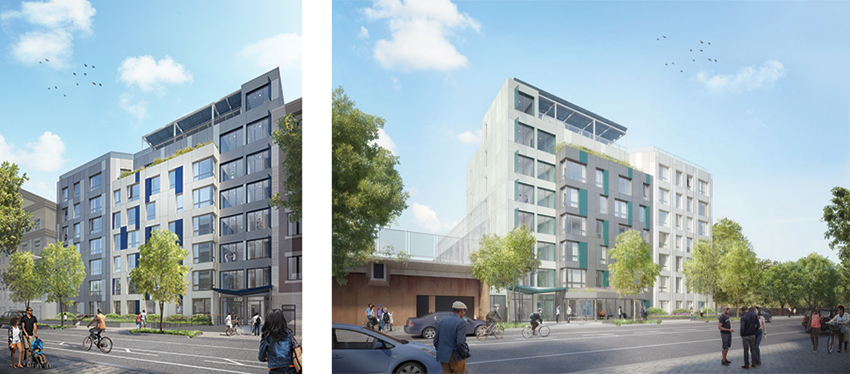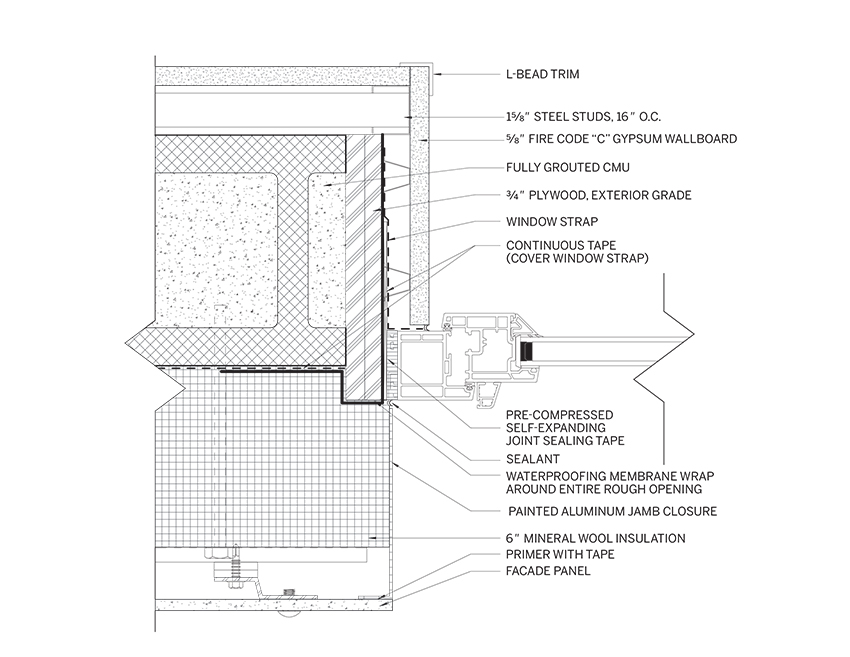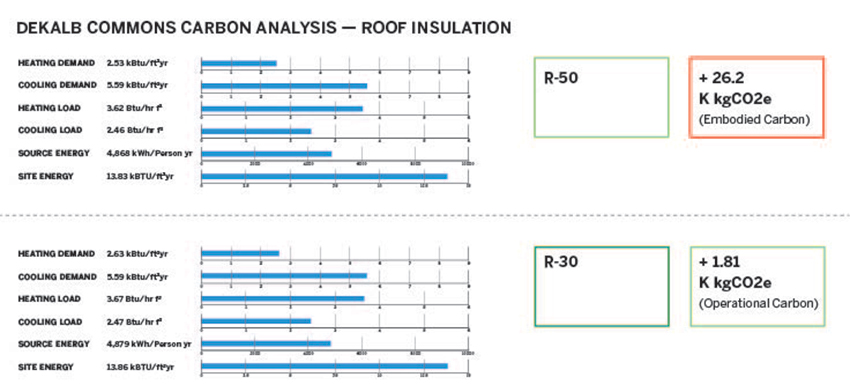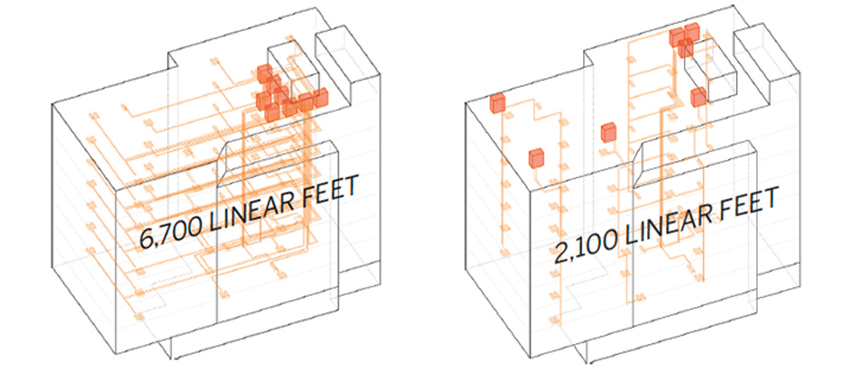View course on architecturalrecord.com »
For more than 30 years, Passive House principles have been a valuable guide to making buildings energy efficient. But now, with steady improvements in our understanding of embodied carbon—the carbon emitted when building materials are created, transported, and installed—the overall carbon impact of Passive House construction has become a subject of concern.

Photo courtesy of NIGHTNURSE IMAGES/MAGNUSSON ARCHITECTURE AND PLANNING
DEKALB COMMONS, Magnusson Architecture and Planning's affordable-housing complex in Brooklyn, New York, will seek Passive House certification.
Just how much energy does it take to make the added insulation, extra layers of glazing, and other features required to meet Passive House standards, compared to how much energy those features might save over time? “A decade ago, we would talk about the tremendous benefits of operational-energy savings,” says Alan Barlis, a principal at BarlisWedlick, a New York–based firm that has completed about 25 certified Passive House buildings. “Today we tell the rest of the story, and a big part of that story is embodied carbon.”
A particular concern is that the large amount of carbon emitted by spray-foam insulation, which is used in some Passive House buildings, will cancel out the expected operational-energy savings. But proponents of Passive House standards say there are many other kinds of insulation, and that Passive House buildings need not be high in embodied carbon. Bronwyn Barry, a San Francisco architect who works pro bono as the policy lead for the New York–based Passive House Network (until recently called the North American Passive House Network), says, “We’re starting to pay close attention to embodied carbon. What we’ve seen from our early studies is that the choices homeowners make about things like square footage have a greater impact on embodied carbon than the decision to follow Passive House standards.”
Those standards, developed in Germany in the 1980s, require buildings to be heavily insulated and practically airtight, minimizing heating and cooling loads. They also mandate high-efficiency ventilation systems to circulate fresh air. Thousands of buildings have been certified by the international Passive House Institute, or PHI, and its competitor, the Chicago-based Passive House Institute U.S. (PHIUS), and the numbers are increasing sharply. Plus, experts say, for every building certified there may be a dozen or more that follow some or all of the Passive House principles but whose owners haven’t sought certification.
Despite the name, only some Passive House structures are houses. The principles can be applied to any building type. In New York, Architecture Research Office is designing a primary school and a high school that meet Passive House standards. In New Haven, a concrete office building by Marcel Breuer from 1968 recently reopened as the Hotel Marcel (RECORD, June 2022), which is expected to receive Passive House certification, in part because the building’s thick concrete walls provide thermal mass, helping stabilize indoor temperatures.
In terms of reducing operational energy, “Passive House has been transformative,” says Kate Simonen, chair of the architecture department at the University of Washington and director of the nonprofit Carbon Leadership Forum. But, she adds, “If you don’t do an embodied-carbon analysis, there could be serious unintended consequences”—that is, buildings using more energy, overall, than they would have if they weren’t built to Passive House standards.
A 2013, study of a single-family Passive House residence in Belgium found it used, in total, 3.8 percent more energy over an 80-year period than a standard house with the same geometry, structure, finishes, and number of residents, which the authors attributed to the energy used to make the Passive House building’s “large amount of insulation and the triple-glazed high-efficiency windows.” To make sure embodied carbon is taken into account, they argued, “current building-energy-efficiency certifications should widen their system boundaries.”
A more recent study considered several possible energy-saving retrofits to a 40-year-old house in Sweden. The study found that, compared to achieving the high level of insulation required under new energy codes, meeting the even stricter Passive House standards resulted in a tiny additional operational-energy savings but a huge increase in embodied carbon. The study’s authors concluded that to optimize energy savings, stopping short of strict Passive House rules might be the best solution. They also suggested that future building codes consider embodied as well as operational energy.

Photo courtesy of MAGNUSSON ARCHITECTURE AND PLANNING
DEKALB COMMONS — WINDOW JAMB
Materials Matter
Most of a building’s embodied carbon is attributable to its materials. “We have to be careful not to pursue energy efficiency without considering the climate impact of materials,” says Chris Magwood, director of research at the Canadian organization Builders for Climate Action. “Since the climate feels the impacts from a building’s materials and its operation in the same way,” he says, “we won’t start making the best decisions until we start looking at both of these impacts together.”
To help architects do that, the Passive House Network recently introduced PHribbon, an app designed to help architects compute the embodied carbon of their buildings. It works with the Passive House Planning Package, a program used to calculate the operational-energy requirements of PHI projects. PHribbon displays the carbon contribution of each building material, giving designers a chance to pick lower-emission alternatives, perhaps exchanging metal siding for wood, and helping them determine how much insulation will achieve the lowest overall energy use.
The current version of PHribbon takes project location into account, which is important because the carbon intensity of electricity production varies from place to place. The greener the electricity, the longer it will take for operational-energy savings to offset a building’s embodied carbon. Indeed, in a place like Vermont, which relies largely on hydroelectricity, using the amount of insulation required to meet Passive House standards may be worse, from a carbon-emissions standpoint, than insulating less thoroughly.
Luckily for designers, not all insulation is created equal. Gabrielle Brainard, a building-enclosure expert who teaches at Pratt Institute, says that, of the kinds of insulation available today, “foam is the worst,” in part because it’s made of fossil-fuel based plastics, and in part because hydrofluorocarbon, a blowing agent required for some insulation systems, has a global-warming potential—a measure of its ability to trap heat in the atmosphere—at least 1,000 times that of carbon dioxide.
In place of foam, she recommends mineral wool and bio-based insulation products, such as dense-pack cellulose (aka recycled newsprint). “Wood-fiber-insulation board is even better, from a carbon perspective,” she says. However, several architects said that getting clients to pay for anything but inexpensive foam insulation can be difficult.
“We’ve made a commitment to try to use non-foam-, non-petroleum-based products,” says Barlis. “But clients are going to want to save money, and spray foam wins every time.” In some projects, BarlisWedlick combines products. The firm will use mineral wool or blown-in cellulose where possible, and spray foam for places that are hard to reach.
Wayne Turett, an architect who designed his own house on eastern Long Island to Passive House standards, says, “In an ideal world, I would eliminate spray-foam insulation.” Dense-pack cellulose is, he says, “the ideal insulation. But it can be tough to find, and even tougher to find someone to properly install it.” (According to Brainard, spray foam sticks to building materials and can be blown into open cavities. By contrast, dense-pack cellulose needs to be held in place during installation; cavities need to be filled carefully to reach every corner and to prevent settling of the material.)
Ken Levenson, the executive director of the Passive House Network, said his “guess” is that foam is used less in Passive House buildings than in buildings generally, simply because Passive House practitioners “tend to think holistically about the environment. People who are thinking about embodied carbon are making good embodied-carbon decisions. People who aren’t, aren’t.”

Photo courtesy of MAGNUSSON ARCHITECTURE AND PLANNING
THE DESIGN team for Dekalb Commons found that the embodied-carbon savings of using less roof insulation outweighed the operational-carbon benefit of using more.
Passive House proponents point out that the standards are about more than saving operational energy. “An efficient envelope has other benefits, in terms of comfort, resilience, and durability,” says Brainard. And there is one way that following Passive House standards can actually reduce a building’s embodied carbon: if the house is so well insulated that it doesn’t require mechanical heating or cooling, you “save the carbon impacts of making that equipment,” Simonen says.
Barry, the San Francisco architect, points out that “Passive Houses tend to be compact—more efficient shapes with less of a foundation”—which reduces embodied carbon. In addition, she said, Passive House buildings that use solar power will require fewer photovoltaic panels than those with higher operational-energy needs. And those panels tend to be high in embodied carbon.
Barry recently ran her first project—a house already under construction—through the PHribbon software. “I think I would have made different choices of some materials. But none of those choices were Passive House–specific.” She still has time, she says, to make one change: substituting fiber-cement board for the standing-seam metal originally specified as siding. “In the Passive House community, we’ve been talking about embodied carbon for at least 10 years. But 10 years ago, there wasn’t enough data.” Now, she says, “we can start to see the impact of these different choices.”
That’s why proponents say it’s unfair to blame Passive House standards alone for high embodied carbon. Says Levenson, of the Passive House Network, “Build Passive Houses out of wood and straw and it’s win-win.”
Dissecting the Data
“Balancing embodied and operational carbon is crucial if we are going to get anywhere near the emissions drawdown needed to combat climate change,” says Sara Bayer, associate principal and director of sustainability at New York–based Magnusson Architecture and Planning, where the majority of projects follow Passive House principles.
Dekalb Commons is a two-building, 85-unit affordable-housing complex in the Bedford-Stuyvesant section of Brooklyn. The development, slated to open in 2024, was designed by Magnusson to meet the certification standards of PHIUS. That means the development is expected to use very little operational energy. But the architects also focused on embodied-carbon reduction. Using WUFI (modeling software specifically for Passive House projects) and EC3 (a free tool focused on the emissions associated with construction materials), they identified the points at which further material investment produces diminishing returns—that is, where operational-energy savings are outweighed by resulting increases in embodied carbon.
The effort to reduce embodied carbon is reflected in the very massing of the two seven-story buildings that make up the Commons. The architects aimed for the maximum density—consistent with other goals, such as the desire to set the buildings back from the street. That’s because shared amenities and systems—everything from elevators to stormwater detention tanks—can serve more people with a diminishing investment of materials per capita.

Photo courtesy of MAGNUSSON ARCHITECTURE AND PLANNING
DEKALB COMMONS – REFRIGERANT-PIPING OPTIONS ORIENTING distribution vertically decreases the amount of piping necessary and also reduces the potential for refrigerant leaks—a key source of greenhouse-gas emissions.
Once the buildings’ density was established, the architects turned to their surface-to-volume ratio (sometimes known as form factor). That ratio affects the building’s ability to retain heat; the lower it is, the less insulation the building requires. But there are further advantages to reducing surface area. As Bayer and Carmel Pratt, director of new construction at Bright Power, an energy consulting firm that worked on the project, wrote earlier this year in an online article for Passive House Accelerator, a magazine and support network, “A good form factor also typically goes hand-in-hand with the minimization of cantilevers, which necessitate large structural members, and other gymnastics that add cost and embodied carbon that may not be essential to creating a beautiful and desirable place to live and thrive.”
Windows were sized to maximize daylight while minimizing heat gain in the warmer months. They were also arranged so as to make the most efficient use of the medium-density fiber-cement cladding selected for the building’s exterior. Minimizing waste is another way to reduce embodied carbon while also saving money, Bayer notes.
The cladding Magnusson selected was configured as a rainscreen that uses the insulation behind it—a dense mineral wool—for support. This strategy reduces the need for aluminum or steel framing, saving both dollars and carbon. True, using insulation for support limits the weight of the cladding to less than 10 pounds per square foot, Bayer says, “but that still leaves many choices.”
In choosing the other materials for Dekalb Commons, Bayer and her colleagues gravitated to those with relatively low embodied carbon (relying, whenever possible on manufacturers’ Environmental Product Declarations, or EPDs). Then they weighed the embodied-carbon savings against the corresponding operational-energy increase over 10 years. The architects also considered adding 2 inches of thickness to slabs and below-grade walls to increase thermal mass, but found this would not provide any significant reductions in heating and cooling loads. In fact, the increase in embodied carbon was nearly 70 times the annual operational-carbon benefit. (This, Bayer and Pratt wrote, confirms the expectation “that reducing concrete at every opportunity is, at the moment, almost always beneficial for holistic carbon reduction.”) Similarly they found that, while their usual goal with roof insulation on multifamily housing is a value of R-50, going down to R-30 decreases embodied carbon more than it increases operational energy. They determined that it would take almost 145 years of operational-carbon savings to offset the heightened embodied carbon of an R-50 roof compared to an R-30. For similar reasons, they chose double-paned rather than triple-paned windows.
In their search for low-embodied-carbon materials, the architects found that manufacturers are willing to innovate. For example, concrete suppliers often will devise mixes that minimize the use of carbon-intensive Portland cement by substituting industrial waste products, including ground post-consumer glass.
The Dekalb Commons’ embodied-carbon analysis even extended to the configuration of mechanical systems. For instance, the design team limited the length of refrigerant piping by organizing the distribution vertically instead of horizontally. The orientation cut piping length by more than two-thirds while simultaneously reducing the potential for refrigerant leaks—a key source of greenhouse-gas emissions.
Bayer says she is lucky. In New York, affordable housing can only receive city funding if it meets the standards of Enterprise Green Communities, an environmental-certifying organization focused on affordable housing (and part of the nonprofit Enterprise Community Partners). For that reason, there is almost always an energy consultant on the design team, which, she says, has been “amazing for the development of energy-efficient affordable housing.”
There’s just one problem, Bayer says: “Addressing embodied carbon is not required —yet.”
Supplemental Materials:
Sara A. Bayer, Carmell Pratt. "A Delicate Balance: Weighting Embodied vs. Operational Carbon, Part Two.” Passive House Accelerator, March 17, 2022.












